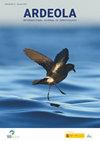森林覆盖对智利外来人工林猛禽丰度的影响
IF 1.2
4区 生物学
Q2 ORNITHOLOGY
引用次数: 1
摘要
总结。栖息地专家,如森林猛禽,通常更容易受到大规模森林的影响。许多工业种植园系统中最具特色和争议的一个方面是使用空地采伐作为一种采伐方法,这种方法产生了高度对比的土地覆盖类型的马赛克,例如与几乎没有植被的地区相邻的树木区域。我们探索了智利中南部森林覆盖对栖息地通用型和森林专门型猛禽数量的影响。在2016 - 2018年繁殖季节,我们在以9×9km平方内3×3km样地为中心的149个采样点进行了584次回放调查。森林专家红腿猫头鹰Strix rufipes在当地尺度上显示了与森林覆盖的正相关关系。然而,在这项研究中,我们发现其他森林专家没有显著的关系。大多数生境通才物种与森林覆盖呈负相关或非线性关系,在森林水平中等和开阔地区的景观中物种丰度更高。有趣的是,具有最高统计支持度的模型将森林覆盖总量(原生林+人工林)作为预测因子,这表明生境通用型物种在天然林和人工林之间没有显著区别。我们的研究结果表明,通才和森林专家猛禽都可以利用智利中南部以外来种植园为主的景观。-桑坦德,F,阿尔瓦拉多O, s, &埃斯蒂德斯,C.F.(2021)。智利外来人工林中森林覆盖对猛禽丰度的影响中国生物医学工程学报,28(6):391-408。本文章由计算机程序翻译,如有差异,请以英文原文为准。
Effect of Forest Cover on Raptor Abundance in Exotic Forest Plantations in Chile
Summary. Habitat specialists, such as forest raptors, are generally more likely to suffer from the impacts of large-scale forestry. One of the most characteristic and controversial aspects of many industrial plantation systems is the use of clearcutting as a harvesting method, which generates a mosaic of highly contrasting land cover types, such as wooded areas adjacent to zones practically devoid of vegetation. We explored the effect of forest cover on the abundance of habitat-generalist and forest-specialist raptors in South-central Chile. During the 2016 to 2018 breeding seasons, we conducted 584 playback surveys at 149 sampling points centred on 3×3km plots within 9×9km squares. The Rufous-legged Owl Strix rufipes, a forest specialist, showed a positive relationship with forest cover at the local scale. However, we found no significant relationships for other forest specialists in this study. Most habitat-generalist species showed a negative or non-linear relationship with forest cover, with greater species abundances observed in landscapes with intermediate levels of forest and open areas. Interestingly, the models with the highest statistical support included total forest cover (native forest + plantations) as a predictor, suggesting that the habitat-generalist species did not significantly discriminate between natural and artificial forests. Our results show that both generalist and forest-specialist raptors can use landscapes dominated by exotic plantations in South-central Chile.—Santander, F., Alvarado O., S. & Estades, C.F. (2021). Effect of forest cover on raptor abundance in exotic forest plantations in Chile. Ardeola, 68: 391-408.
求助全文
通过发布文献求助,成功后即可免费获取论文全文。
去求助
来源期刊
CiteScore
2.30
自引率
6.20%
发文量
16
审稿时长
>12 weeks
期刊介绍:
Ardeola: International Journal of Ornithology is the scientific journal of SEO/BirdLife, the Spanish Ornithological Society. The journal had a regional focus when it was first published, in 1954. Since then, and particular during the past two decades, the journal has expanded its thematic and geographical scope. It is now a fully international forum for research on all aspects of ornithology. We thus welcome studies within the fields of basic biology, ecology, behaviour, conservation and biogeography, especially those arising from hypothesis-based research. Although we have a long publication history of Mediterranean and Neotropical studies, we accept papers on investigations worldwide.
Each volume of Ardeola has two parts, published annually in January and July. The main body of each issue comprises full-length original articles (Papersand Review articles) and shorter notes on methodology or stimulating findings (Short Communications). The publication language is English, with summaries, figure legends and table captions also in Spanish. Ardeolaalso publishes critical Book Reviewsand PhD-Dissertation Summaries; summarising ornithological theses defended in Spain. Finally there are two Spanish-language sections, Ornithological News; summarising significant recent observations of birds in Spain, and Observations of Rare Birds in Spain, the annual reports of the Spanish Rarities Committee.

 求助内容:
求助内容: 应助结果提醒方式:
应助结果提醒方式:


